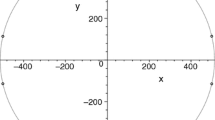Abstract
In this work we develop a geometric approach to the study of rank metric codes. Using this method, we introduce a simpler definition for generalized rank weight of linear codes. We give a complete classification of constant rank weight code and we give their generalized rank weights.
Similar content being viewed by others
References
Bonisoli A.: Every equidistant linear code is a sequence of dual Hamming codes. ARS Comb. 18, 181–186 (1983).
Cai N., Yeung R.W.: Secure network coding. In: Proceedings IEEE International Symposium on Information Theory, p. 323 (2002). https://doi.org/10.1109/ISIT.2002.1023595.
Csajbók B., Marino G., Polverino O., Zullo F.: Maximum scattered linear sets and MRD-codes. J. Algebr. Comb. 46(3), 517–531 (2017). https://doi.org/10.1007/s10801-017-0762-6.
Csajbók B., Marino G., Polverino O., Zullo F.: A special class of scattered subspaces (2019).
Delsarte P.: Bilinear forms over a finite field, with applications to coding theory. J. Comb. Theory Ser. A 25(3), 226–241 (1978). https://doi.org/10.1016/0097-3165(78)90015-8.
Ducoat J., Kyureghyan G.: Generalized rank weights: a duality statement. Top. Finite Fields 632, 101–109 (2015).
El Rouayheb S.Y., Soljanin E.: On wiretap networks II. In: 2007 IEEE International Symposium on Information Theory, pp. 551–555 (2007).https://doi.org/10.1109/ISIT.2007.4557098.
Gabidulin E.: Theory of codes with maximum rank distance (translation). Problems Inform. Transm. 21, 1–12 (1985).
Gabidulin E.M., Paramonov A.V., Tretjakov O.V.: Ideals over a non-commutative ring and their application in cryptology. In: Davies D.W. (ed.) Advances in Cryptology—EUROCRYPT ’91, pp. 482–489. Springer, Berlin (1991).
Giuzzi L., Zullo F.: Identifiers for MRD-codes. Linear Algebra Appl. 575, 66–86 (2019). https://doi.org/10.1016/j.laa.2019.03.030.
Helleseth T., Kløve T., Mykkeltveit J.: The weight distribution of irreducible cyclic codes with block lengths \(n_1((q^1-1)N)\). Discret. Math. 18(2), 179–211 (1977). https://doi.org/10.1016/0012-365X(77)90078-4.
Hill R.: Caps and codes. Discret. Math. 22(2), 111–137 (1978). https://doi.org/10.1016/0012-365X(78)90120-6.
Jurrius R., Pellikaan R.: The extended and generalized rank weight enumerator of a code. ACM Commun. Comput. Algebra 49(1), 21–21 (2015). https://doi.org/10.1145/2768577.2768605.
Jurrius R., Pellikaan R.: On defining generalized rank weights. Adv. Math. Commun. 11, 225 (2017). https://doi.org/10.3934/amc.2017014.
Kurihara J., Matsumoto R., Uyematsu T.: Relative generalized rank weight of linear codes and its applications to network coding. IEEE Trans. Inform. Theory 61(7), 3912–3936 (2015). https://doi.org/10.1109/TIT.2015.2429713.
Lavrauw M., Van de Voorde G.: Field reduction and linear sets in finite geometry. Top. Finite Fields 632, 271–293 (2015).
Liu Z., Chen W.: Notes on the value function. Des. Codes Cryptogr. 54(1), 11 (2009). https://doi.org/10.1007/s10623-009-9305-z.
Lunardon G.: Normal spreads. Geom. Dedicata 75(3), 245–261 (1999). https://doi.org/10.1023/A:1005052007006.
Lunardon G.: MRD-codes and linear sets. J. Comb. Theory Ser. A 149, 1–20 (2017). https://doi.org/10.1016/j.jcta.2017.01.002.
Martínez-Peñas U.: On the similarities between generalized rank and Hamming weights and their applications to network coding. IEEE Trans. Inform. Theory 62(7), 4081–4095 (2016). https://doi.org/10.1109/TIT.2016.2570238.
Morrison K.: Equivalence for rank-metric and matrix codes and automorphism groups of Gabidulin codes. IEEE Trans. Inform. Theory 60(11), 7035–7046 (2014). https://doi.org/10.1109/TIT.2014.2359198.
Oggier F., Sboui A.: On the existence of generalized rank weights. In: 2012 International Symposium on Information Theory and its Applications, pp. 406–410 (2012).
Ozarow L.H., Wyner A.D.: Wire-tap Channel II. In: Beth T., Cot N., Ingemarsson I. (eds.) Advances in Cryptology, pp. 33–50. Springer, Berlin (1985).
Polverino O.: Linear sets in finite projective spaces. Discret. Math. 310(22), 3096–3107 (2010). https://doi.org/10.1016/j.disc.2009.04.007. (Combinatorics 2008).
Ravagnani A.: Generalized weights: an anticode approach. J. Pure Appl. Algebra 220(5), 1946–1962 (2016). https://doi.org/10.1016/j.jpaa.2015.10.009.
Sheekey J.: A new family of linear maximum rank distance codes. Adv. Math. Commun. 10, 475 (2016). https://doi.org/10.3934/amc.2016019.
Sheekey J.: Mrd codes: constructions and connections. In: Schmidt K.U., Winterhof A. (eds.) Combinatorics and Finite Fields: Difference Sets, Polynomials, Pseudorandomness and Applications, vol. 23, pp. 255–286. De Gruyter, Berlin (2019). (chap. 13).
Sheekey J.: New semifields and new MRD codes from skew polynomial rings. J. Lond. Math. Soc. (2019). https://doi.org/10.1112/jlms.12281.
Sheekey J., Van de Voorde G.: Rank-metric codes, linear sets, and their duality. Des. Codes Cryptogr. (2019). https://doi.org/10.1007/s10623-019-00703-z.
Tsfasman M.A., VlăduŢ S.G.: Codes and Their Parameters, pp. 5–35. Springer, Dordrecht (1991). https://doi.org/10.1007/978-94-011-3810-9_1.
Tsfasman M.A., Vladut S.G.: Geometric approach to higher weights. IEEE Trans. Inform. Theory 41(6), 1564–1588 (1995).
Wei V.K.: Generalized Hamming weights for linear codes. IEEE Trans. Inform. Theory 37(5), 1412–1418 (1991). https://doi.org/10.1109/18.133259.
Acknowledgements
I would like to thank Rakhi Pratihar and Prof. Sudhir Ghorparde for their valuable comments and suggestions on this work. I also would like to thank the anonymous reviewer who introduced me to linear sets.
Author information
Authors and Affiliations
Corresponding author
Additional information
Communicated by I. Landjev.
Publisher's Note
Springer Nature remains neutral with regard to jurisdictional claims in published maps and institutional affiliations.
The author is supported by the Swiss National Science Foundation Grant No. 181446.
Rights and permissions
About this article
Cite this article
Randrianarisoa, T.H. A geometric approach to rank metric codes and a classification of constant weight codes. Des. Codes Cryptogr. 88, 1331–1348 (2020). https://doi.org/10.1007/s10623-020-00750-x
Received:
Revised:
Accepted:
Published:
Issue Date:
DOI: https://doi.org/10.1007/s10623-020-00750-x
Keywords
- Coding theory
- Rank metric codes
- Constant rank weight
- Linear code
- Classification
- Geometric approach
- Linear sets




